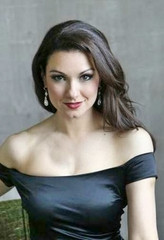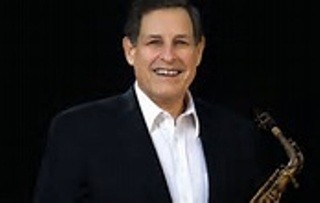|
Back
Sax, Violins, And Late Romance New York
Merkin Concert Hall
06/07/2015 -
Ottorino Respighi: Il tramonto [1]
Adolf Busch: Quintet for Alto Saxophone and Strings [2]
Antonín Dvorák: String Quartet No. 11 in C Major, Opus 61 [3]
Sandra Piques Eddy (Mezzo soprano)
Harvey Pittel (Saxophone), Lisa Gihae Kim [2], Kuan Cheng Lu [2], Anna Rabinova [1], Fiona Simon [3], Sharon Yamada [3], Shanshan Yao [1] (Violins), Katherine Greene [1], Dawn Hannay [2], Robert Rinehart [3] (Viola), Eric Bartlett [2], Eileen Moon [3], Nathan Vickery [1] (Cello)

S. Piques Eddy (© Courtesy of the artist)
When telling friends in the East Village that I was spending my sunny Sunday afternoon experiencing Sax and Violins, eyes widened, showing a new respect...nay, actual reverence for my choice. After all, orgies and sadism are not to be sneezed at.
But when I added that the Sax and Violins were part of a Late Romantic period, they lost their deference. Fornication is fine, but romance is for simpletons.
Still, one could say that, within limits, the three works by the ultra-fine musicians of the New York Philharmonic, were part of a Late Romantic setting. Antonin Dvoøák certainly, Adolf Busch partly, and Ottorino Respighi? That’s a more blurry definition.
The popular orchestral works of Respighi are unhappily not highly respected these days, though his Ancient Airs and Dances transcriptions have never been surpassed. And sometimes one comes upon a rare piece by the composer which doesn’t quite fit anywhere.
Such is Il tramonto (“Sunset”) that peculiar poem by Shelley which is both beautiful and ghastly. We begin with the death of a young boy, go back to his life with a girl, who wakes up to find him dead, and then laments the situation for a year. Nothing could be more Gothic, more fitting for the time.
Respighi loved it, and the form he used–what he called “a lyrical poem”–was the rare combination of mezzo-soprano and string quartet. Perhaps it could be labelled a cantata. Mozart and Beethoven might have said it was a “scena”. But whatever the title, the combination on paper is awesome. Though the performance can never ever be perfectly balanced.
Sandra Piques Eddy was that most dramatic mezzo for this performance. She told the story with unerring skill, though it was difficult to make out the words. Without a program translation for this continuing drama, the varied moods, emotions, feelings were placed in a void.
But the music by the string quartet was amazing. To me, Schoenberg’s Transfigured Night, written 15 years before Respighi’s 1914 work, was in a class by itself. But the Respighi–both in story and music–was in the same class. Those expressionistic intertwinings of lines, the harmonies which seemed to break open the usual scales, the transitions, all seemed more Schoenberg than the usual Impressionistic composers to which the work is compared.
Perhaps I heard this work many years ago, but don’t remember it played with such passion by these players. And only wish I had the poem in which to fit these gorgeous sensations.

H. Pittel (© Courtesy of the artist)
The next work was almost as surprising. Adolf Busch, part of a legendary family of musicians, tried his hand at Adolphe Sax’s instrument, and frankly, I wasn’t expecting much. Yet Harvey Pittel has a reputation for digging out the most interesting works for the instrument, and his piece was–at the least–harmless. At the most, it was flavorful and digestible.
Mr. Pittel’s smooth, lyrical alto saxophone blended in with both viola and cello in the first movement, a piece of utter nostalgia, with a Viennese-style waltz varying with some near-Impressionist harmonies. Mr. Pittel came into his own with the scurrying, hurrying lively scherzo. But the last movement was an utter charmer. Obviously a series of variations, these going from the robust to the fervent to the despairing to the lively, all with Brahmsian invention and inspiration.
And what were the variations about? Perhaps they were original–but they certainly sounded like an improbable “Sweet Rosie O’Grady.” Making the Saxophone Quintet even more charming.
The afternoon ended with a work of equal charm (and certainly more familiarity). Four of the Phil’s best string players, including Associate Principal Cello Eileen Moon, sung through the Dvorák 11th Quartet. That was true in the first movement, yet I must remember the most beautiful duet of violinists Fiona Simon and Sharon Yamada in the cantabile slow movement. Mr. Simon also had a short but utterly beguiling cadenza in the finale.
And no, not even this concert could quite make up for the radiant weather in Manhattan this afternoon. But Dvorák knew how to give the facsimile of springtime in his music, and those four players made appropriate light of their work.
Harry Rolnick
|